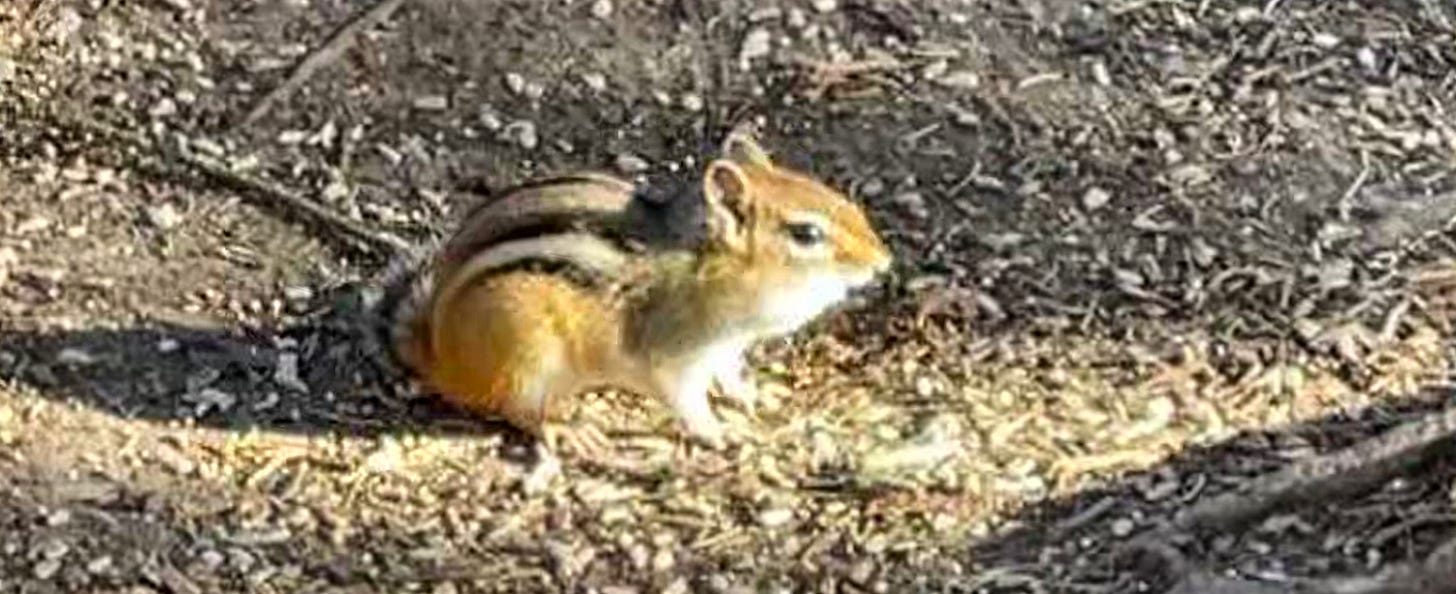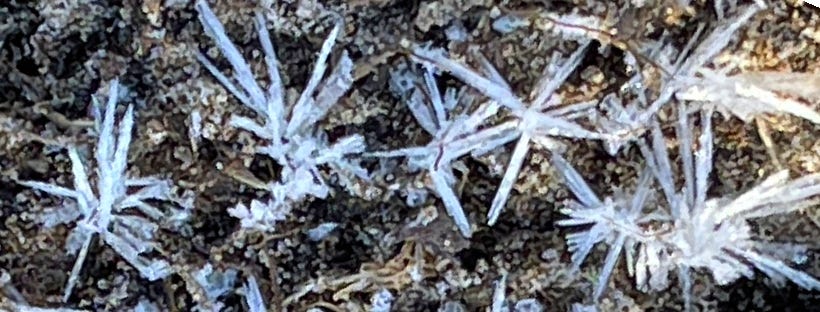Early morning in the peatlands of Mer Bleue
History, facts, nature, wildlife, and stories about this nature area just east of Ottawa
I enjoyed spending the early morning in nature. In freezing temperatures but under a clear blue sky while the sun was gaining strength by the hour. A contrast to my previous visit to Mer Bleue on a recent busy afternoon. The 8000-year-old peatlands are a popular attraction for families; it is not too far from Ottawa, and the boardwalk over the water and the wetlands make it especially popular for the kids.
This morning, there was nobody in this remnant of the last ice age. I had thought of walking one of the trails; there are some 20 kilometers of them. But looking at the many pools of frozen mud and the predicted warming within two hours, I decided to walk the most popular part of this protected area. At the entrance, a sign warned me of rare encounters with coyotes, 'especially in the early morning,' but I was only surrounded by the sights and sounds of countless birds and squirrels. Pro tip (since I read the sign and you didn't): If you encounter a coyote: make yourself bigger, don't run, turn around, or play dead, just slowly step backward. And before I forget: if you have little dogs or minor children, lift them up.
Fur traders and tree logging
As so often in protected nature areas, there is a centuries-long history of increasing human interference before the site was protected. First Nations people only came for some medicinal plants and picked berries for food. But in the 1600's the usual pattern of human destruction of well-balanced habitats started by fur traders who came for the beaver pelts. Tree logging on the higher sand ridges was another disruption, one that we still witness worldwide. As a textbook case of our destruction of the planet, the 20th century shifted our attempts to destroy this unique landscape into a higher gear, draining the land, building railway lines, followed by the designation as a bombing range for practice during the second world war.
A lucky escape
But unlike the well knows stories of how we effectively ruin the environment on the rest of the planet, and a bit paradoxically, it was the ownership of the Canadian Department of National Defense that protected the area after the war when urbanization often swallowed up precious nature areas near the big cities. Mer Bleue's fortunes turned when in the early 1960s, the National Capital Commission was buying up nature and agricultural area's around Ottawa to create the Greenbelt. Mer Bleue was added in 1966, and that was just in time since it was seriously considered the ideal site for a city dump.
There would not have been a green belt around Ottawa if it wasn't for the French architect Jacques Gréber. His report, known as the 1950 Gréber plan, became the model for the urban planning of Canada's capital for half a century. Having lived here for five months, I applaud him for his vision of creating the Green Belt around Ottawa, including his role in including the wonderful Gatineau Park. But as an urban geographer, I am less charmed by the planning inside the city of Ottawa.
In Europe, I am used to doing my work, living, entertainment, education, drinking, and dining, all within my home's walking distance. And we mostly take the bicycle if we have to go further. I either walked or cycled to work in all the jobs that I ever had in the Netherlands. The first things I noted in Ottawa are cars' priority and the enormous amount of space they need in wide lanes crossing the city. And then, there is Gréber's deliberate separation of living, working, and other city functions. Perhaps in a post-covid world, where more people will work from home, there will be space available in those offices to try a different concept.
On the other hand, I understand that without Gréber, my photoshoots of Ottawa would always have local industry smokestacks in the background, and railway lines would divide the city. Ottawa Citizen had an interesting article about Gréber in 2015. Now that the winter is over, I will soon try to cycle in Ottawa. You may read about this experience someday in another edition of the planet.
As I wrote, I admire Greber's vision of creating and conserving a green belt around Ottawa, including the beautiful Mer Bleue. Looking at this concept through my Dutch geographer's eyes, I consider this visionary plan an inverse version of the 'Randstad,' the 'rim city,' or 'ring city,' in the Netherlands. We have an area of green, surrounded by cities. I suppose that Gréber would have coined this concept as the Citybelt.
Unlike Ottawa, our encirclement of green grew historically since the 17th century. We had no idea how to build cities in the wet meadows and marshlands between our biggest cities, so we used them for agriculture and peat production.
It was only when the founder of KLM, the world's oldest airline that you can still fly today, Albert Plesman, described his aerial view of the Netherlands that we realized what a marvel of city planning we had created. We cheat a bit in our name-giving since it is not a complete ring; there is less urbanization in the southeastern part, making it more like a horseshoe. Nor is there only green in the Green Heart; you do find some cities there. But it helps to visualize, and nor does Ottawa's Greenbelt claim to be an unbroken area of green.
Randstad
If the Dutch word Randstad rings a bell, you are not mistaken. The employment agency was founded in the Netherlands in 1960 and named after the ring city. Frits Goldschmeding chose this name since he wanted to expand to several cities in the Randstad, like Amsterdam, Rotterdam, and The Hague. It shows the ambition of Goldschmeding, who earned a total income of 4.84 dollars in his first year. Not easily discouraged, he continued to build what is now the world's largest employment agency with total revenue in 2020 of more than 20 billion euro, more than 23 billion dollars.
I passed one of those well-known Randstad signs on my way to Mer Bleue. It is about a twenty-minute drive from the city, and soon I was the only car on the road. Mer Bleue, the 'blue sea' earned its name because of its beauty in the early morning. Have a look at this picture.
These peatlands are not at all unique in Canada. In fact, about 12 percent of Canada's surface, the second-largest country in the world, is covered by peatlands. But these are typically found in the north. Visiting this peatland that ended up so far to the south is like making an excursion to a boreal forest in Northern Canada. In its geological past, this area was covered by several kilometers of ice. Later the area became part of an inlet when the ocean flooded it. When the sea receded, the peatlands developed where once the Ottawa River had flowed. The area is since 1995 designated as a Wetland of International Significance under the Ramsar Convention, also known as the Convention on Wetlands.
Birds and squirrels
I enjoyed seeing so many birds, like the Black-capped Chickadee, a Red-winged Blackbird, American Robins, several Downy Woodpeckers, and a beautiful white-blue bird that I didn't recognize. I also saw many squirrels and what I believed to be a chipmunk, but after reading about them, I found out it is also a squirrel, known as the Golden-mantled Ground Squirrel. Another pro tip (since I have the advantage of having learned this moments ago): look at the head: stripes on the back, but no stripes on the head, and a white eye-ring. These are the tricks to recognize this type of squirrel. This is one that I saw this morning.
On one of the forest trails, I found a vast area full of water chrystals. When I looked closer and saw their fragile beauty, I realized that I must have trampled on hundreds of them. They looked like this.
I walked away very carefully, not to step on them. Even though knowing that with the rising sun, all would be gone in the next fifteen minutes, but don't worry, they will be back if you visit here someday on an early morning in April.
The ice chrystals also gave a beautiful glow on Mer Bleue in the morning sunlight, as you saw in one of the other pictures; here, you see them on the leaves.
That's it for today. Are you looking for a present for a friend? Consider giving a subscription to The Planet. Here is the button to do so. Perhaps you make your friend happy, and you would certainly make me happy.
For those that celebrate, I wish you a Happy Easter, and I wish a wonderful Sunday for everybody that reads this in what I noted is an increasingly diverse number of countries all over the world.













You see so much. Happy Easter.
Good morning and Happy Eastern, Alexander.
All your photos give a nice feel of the environment you walking through. I think that the sunrise photo is awesome. And the Cattail plants skirting the water's edge, is also a wonder of nature. Their rhizomes are edible and evidence of preserved starch grains on grinding stones suggests they were already eaten in Europe 30,000 years ago. There are amazing more Cattail uses on Wikipedia to read about, if one is so inclined. I loved the experience you described with the birds, squirrel, ice crystals, and Blue Mer. I wonder if there is some salt left in the soil from the(Old) Sea? And yes, building smarter in the future with nature in mind is a must. Thank you for this morning walk . . . (-: